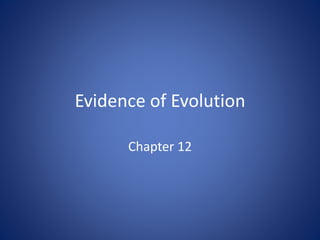
Evidence of evolution
- 4. Fossil Record • Evidence of organisms from long ago • Formed in many ways • Layers of earth show relative age of fossils
- 5. Formation of Fossils A compression fossil is a fossil preserved in sedimentary rock that has undergone physical compression.
- 6. Formation of Fossils Petrification is the process by which organic material is converted into stone through the replacement of the original material and the filling of the original pore spaces with minerals.
- 7. Formation of Fossils Compression fossils, such as those of fossil ferns, are the result of chemical reduction of the complex organic molecules composing the organism's tissues. In this case the fossil consists of original material, albeit in a geochemically altered state. Often what remains is a carbonaceous film known as a phytoleim, in which case the fossil is known as a compression. Often, however, the phytoleim is lost and all that remains is an impression of the organism in the rock—an impression fossil.
- 8. Formation of Fossils Molds and Casts In some cases, the original bone or shell dissolves away, leaving behind an empty space in the shape of the shell or bone. This depression is called a mold. Later, the space may be filled with other sediments to form a matching cast in the shape of the original organism. Many mollusks (bivalves, snails, and squid) are commonly found as molds and casts because their shells dissolve easily.
- 9. Formation of Fossils Oozing tree sap can trap insects. When the sap (or resin) fossilizes, it becomes amber.
- 10. Dating Fossils • Relative Dating—based on where in layers of rock it is. – Does NOT assign an exact age • Absolute Dating—test fossil or sediment around it to get a date range – Radiometric Dating—uses radioactive isotopes • Based on half life—amount of time it takes for half the substance to decay • Ex. Carbon-14
- 11. Carbon 14 Dating •Carbon dating is used to date archaeological samples to the relative dates that the sample was from. •The half-life of Carbon-14 is approximately 5,700 years, and as long as there is traces of Carbon-14 in something, you can age it accurately. •After an animal or other living thing dies, Carbon-14 slowly forms back into Nitrogen and returns back into the atmosphere, but regular Carbon-12 does not decay so if all the Carbon-14 decays, then you can not age that material
- 12. Biogeography Darwin noticed: – The further away he got from home, the more different the species were from those he recognized. In particular, older animal groups often were more widespread. – The closer (geographically) related animals were, the more likely they were to be similar. – The further apart two animals, the more time they've had to evolve in their own direction. • Using fossil evidence and continental drift, the distribution of organisms can be explained (why llamas occur in South America and their closest living relatives (camels) live in Asia).
- 13. Continental Drift PANGEA 280 million years ago
- 14. Comparative Anatomy • Homologous structures—structures that have a common origin, but may be used for different things. • Analogous structures—structures that look similar, but have different origins (e.g. wings in birds and insects).
- 15. Comparative Anatomy • Homologous Structures: Similar structures in different living organisms because of a common ancestor
- 16. Comparative Anatomy • Analogous Structures:
- 17. Comparative Anatomy • Convergent evolution—animals that are different evolve similar structures due to similar environmental pressures. A classic example is the body shape of fish, dolphins and ichtyosaurs (extinct). These animals are unrelated, yet have very similar body shapes.
- 19. Embryology • Embryos show common ancestry. – For example, gill slits in human embryos. • Many embryos from totally different species look identical at various stages in their development.
- 21. Human embryo
- 22. Embryology
- 23. Biochemistry • All organisms use DNA/RNA and proteins as basis of inheritance • Similar species have DNA that is very similar. This can be used to establish lineages and other relationships. • This works even on a larger scale such as between species. • Can use DNA as a molecular clock to estimate when organisms diverged (became different)
Editor's Notes
- “Geologic Clock with events and periods” by Woudloper. Released into public domain by the copyright holder
- Geologic Time Scale, “Table of geologic time” https://en.wikipedia.org/wiki/Geologic_time_scale#Table_of_geologic_time. Converted into an image by Lumen Learning.
- Estimating the Age of Fossils. Provided by: Boundless. Located at: https://www.boundless.com/biology/textbooks/boundless-biology-textbook/evolution-and-the-origin-of-species-18/evidence-of-evolution-129/estimating-the-age-of-fossils-520-13098/images/sedimentary-layers/. License: CC BY-SA: Attribution-ShareAlike
- “Compression fossil” https://en.wikipedia.org/wiki/Compression_fossil “Pterodactylus Antiquus p and cp” by Ryan Somma. Licensed under a CC-BY-SA 2.0 Generic license. https://en.wikipedia.org/wiki/File:Pterodactylus_antiquus_p_and_cp.jpg
- “Petrification” https://en.wikipedia.org/wiki/Petrifaction “Petrified wood closeup 2” by Daniel Schwen. Licensed under a CC-BY-SA 3.0 Unported license. https://commons.wikimedia.org/wiki/File:Petrified_wood_closeup_2.jpg
- “Fossil” https://en.wikipedia.org/wiki/Fossil “Fossil-crab” by Dzhanette. Released into public domain by the copyright holder. https://commons.wikimedia.org/wiki/File:Fossil-crab.jpg
- Image and caption from Boundless
- Left: “Gouttes Drops Resin 2” by Emmanuel Boutet. Licensed under a CC-BY-SA 3.0 Unported license. https://en.wikipedia.org/wiki/File:Gouttes-drops-resine-2.jpg Right: “Amber 2” by Anders L. Damgaard. Licenced under a CC-BY-SA 3.0 Unported license. https://en.wikipedia.org/wiki/File:Amber2.jpg
- Image from Boundless
- Left: “Pangea” By Kieff. Licensed under a CC-BY-SA 3.0 Unported license. http://commons.wikimedia.org/wiki/File:Pangaea.png Right: “Laurasia-Gondwana” by Lenny Wikidata. Licensed under a CC-BY 3.0 Unported license. http://en.wikipedia.org/wiki/File:Laurasia-Gondwana.svg Bottom: “Eckert 4” by Ktrinko. Licensed under a CC0 1.0 Universal Public Domain Dedication. http://commons.wikimedia.org/wiki/File:Eckert4.jpg
- “Homology Vertebrates” by Волков Владислав Петрович. Licensed under a CC-0 license. https://en.wikipedia.org/wiki/File:Homology_vertebrates.svg
- Image from Boundless
- Left: “Dolphins 300” by NOAA. (Public Domain). https://commons.wikimedia.org/wiki/File:Dolphins_300.jpg Right: “Ichthyosaurus BW” by Nobu Tamura. Licensed under a CC-BY 3.0 Unported license. https://commons.wikimedia.org/wiki/File:Ichthyosaurus_BW.jpg
- “Haeckel Anhropogenie 1874” by J. G. Bach of Leipzig. (Public Domain). http://commons.wikimedia.org/wiki/File:Haeckel_Anthropogenie_1874.jpg
- Public domain image by Zebra.element, available https://en.wikipedia.org/wiki/Pharyngeal_slit#/media/File:Phylogeny_gill_slit.png
- Left: Right: “Tubal Pregnancy with embryo” by Ed Uthman, MD. Released into public domain by the copyright holder. http://commons.wikimedia.org/wiki/File:Tubal_Pregnancy_with_embryo.jpg
- “Image: Common Ancestors” from Boundless
- “Image: Evolutionary Tree” by Boundless, CC-By SA 4.0
- Image by Ahmed376, CC-By SA 3.0, available http://commons.wikimedia.org/wiki/File:Amino_acid_sequence_identity_vs_time_since_species_divergence_for_orthologs_of_EVI5L.png